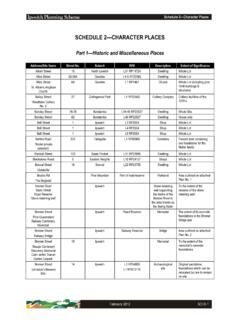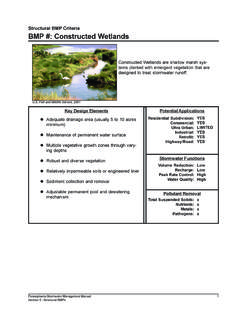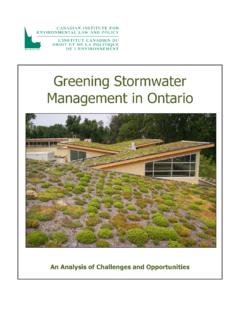Transcription of IMPLEMENTATION GUIDELINE NO. 24 - …
1 IMPLEMENTATION GUIDELINE NO. 24 January 2016 1 stormwater Management Date of Council Resolution These guidelines were originally adopted by Council on 20 September 2011 and took effect from the 26 September 2011 in accordance with section (2) of the Planning Scheme. The guidelines were amended by Council on: 4 December 2012 and took effect on 10 December 2012; 31 January 2014 and took effect on 14 February 2014; and 28 January 2016 and took effect on 29 January 2016. Purpose of the guidelines This GUIDELINE is intended to assist with the IMPLEMENTATION of the Planning Scheme by providing guidance for the management of stormwater runoff as a resource. These guidelines compliment other information available that support integrated water management planning through the provision of specific guidance for flood and disaster management, waterway health objectives and acceptable outcomes for development.
2 Council s IMPLEMENTATION guidelines are intended to apply a standard approach to the interpretation and IMPLEMENTATION of the relevant aspects of the Planning Scheme. They offer a degree of certainty to applicants, Council and the community. Where an applicant is proposing a solution that is different from the guidelines the onus is on the applicant to demonstrate the facts and circumstances to support the solution. This GUIDELINE does not preclude alternative innovative solutions proposed by the developer or applicant. guidelines 1 Background The continued IMPLEMENTATION of conventional water management systems will result in increasing pressure on, and further degradation to, existing water resources as well as perpetuating and adding to nuisance flows and potential flood hazard situations affecting people, vehicles and property.
3 Ipswich City Council is committed to the successful IMPLEMENTATION of integrated water management within the Ipswich local government area. Fundamental to such a strategy is achieving satisfactory management of stormwater runoff from both a quality and quantity perspective. The main principles of stormwater management are as follows: (i) protect existing natural features and ecological processes; (ii) maintain the natural hydrologic behaviour of catchments; (iii) flood control or mitigation measures and to avoid the creation of nuisance flow/flood hazard situations as a result of development; (iv) erosion and sediment control; and (v) protect water quality of surface and ground waters. 2 State Planning Policy Water Quality The State Planning Policy July 2014 (SPP) seeks to ensure that development is planned, designed, constructed and operated to manage stormwater and waste water in ways that supports the protection of environmental values identified in the Environmental Protection (Water) Policy 2009.
4 The SPP sets out what outcomes are to be achieved by the scale and types of development to which the policy applies. Council interests as the assessment manager for development requires that stormwater management address the objectives and goals of this statutory policy. Notably, the SPP does not prevent a local government and assessment manager from addressing the water quality outcomes more stringently or in greater detail than sought by the policy. Accordingly where there is a difference between the SPP and this GUIDELINE , this GUIDELINE provides the necessary identification, information and trigger relating to the proposed development. 3 Integrated Water Management Objectives and Outcomes This section outlines the objectives that proposed developments must achieve within the Ipswich local government area, in relation to: (i) stormwater quantity and flood management; and (ii) stormwater quality and flow management.
5 stormwater Quantity and Flood Management With reference to the Ipswich Planning Scheme and the Queensland Urban Drainage Manual (QUDM), all development and works are to deliver a no-worsening (zero net balance) outcome with respect to stormwater management. The definition of no-worsening applies to: (a) flood levels; (b) flood volumes and storage; (c) velocities; (d) timing; (e) flow characteristics; (f) duration; and (g) cumulative flooding impact. IMPLEMENTATION GUIDELINE No. 24 2 January 2016 The acceptable outcome for potential impacts is for zero change to all the above parameters but may be determined otherwise in consultation with Council and other stakeholders. Reference should also be made to Part 11 Overlays, Division 4 Development Constraints Overlays, Section Flooding and Urban Catchment Flow stormwater Quality and Flow Management Under the SPP and where required by this GUIDELINE , Ipswich City Council requires particular development to satisfy or exceed the design objectives for stormwater quality and flow (quantity) management as outlined in Chapter 2, particularly Tables , and of the Urban stormwater Quality Planning GUIDELINE 2010 for the Ipswich local government area for both the construction and operational phase of development.
6 The determination of these design objectives must be in accordance with Chapter 2 of the Urban stormwater Quality Planning GUIDELINE 2010. Sensitive Receiving Areas For the purpose of applying this IMPLEMENTATION GUIDELINE , specific catchments may be identified as sensitive receiving areas. These have a high sensitivity to producing adverse outcomes in terms of water quality or water quantity management with small or incremental changes from development activity. Additionally, such areas may include catchments where discharge is to an unlined gully or stream and in-situ soil conditions which are determined to be of a high dispersion classification. Where sensitive receiving areas exist, the proposed development must demonstrate negligible change in terms of water quality and flow management measures, ie maintain pre-development conditions in terms of natural hydrology and environmental flows.
7 The identification of sensitive receiving areas is an output of an ongoing sequence of planning studies across the city. Sensitive receiving areas may include, but are not limited to, a waterway corridor (stream orders 1 to 8 inclusive), the Bremer River and Brisbane River corridors, or the catchment of a naturally occurring wetland. Clarification should be sought from Council s Engineering and Environment Branch on telephone number 3810 6980 concerning specific identified catchments prior to undertaking any detailed stormwater quality assessment. stormwater Quality Treatment Design Requirements The following requirements apply for stormwater quality management within the Ipswich local government area where development meets or exceeds the thresholds in Table : (a) Private and Municipal Treatment Devices (General) The design of all stormwater treatment measures including sediment forebays and scour protection should be undertaken in accordance with Healthy Waterways (2006 or current version) Water Sensitive Urban Design Technical guidelines for South East Queensland or in the case of bio-retention systems the Water by Design (2012) Bioretention Technical Design guidelines .
8 Design calculation summaries, design checklists and conceptual design drawings should be provided. (b) Developer Contributed Assets (i) Locations for stormwater Treatment Measures stormwater treatment measures should not be located in unlined waterways with a stream order of 1 to 8 (based on South East Queensland Healthy Waterways mapping) including declared riparian corridors. Additionally, treatment areas should be positioned to satisfy the following assessment criteria: (A) duration of complete vegetation inundation for the critical 5% AEP storm event must be less than seven days; (B) duration for inundation of the surface of bio-retention filter media by the critical 1 Exceedance per Year (EY) storm event must be less than two days; and (C) where bio-retention basin is proposed within a large regional or sub-regional scale, open channel or retardation basin, the surface of bio-retention filter media must be above the peak 1-year ARI flood level; velocities over the bio-retention area for all storm events up to and including peak 5% AEP must be less than 1m/s.
9 For storm events with AEP greater than 5% and up to 1%, velocities over the bio-retention area must be less than 2m/s. (c) Gross Pollutant Pre-treatment Any stormwater discharge pipe that is greater than 525mm diameter must have some form of suitable above-ground Gross Pollutant Trap (GPT) eg trash rack, with sediment forebay which incorporates the provision of a constructed maintenance access track and hardstand area. IMPLEMENTATION GUIDELINE No. 24 January 2016 3 (d) Maintenance Access Maintenance access tracks and hardstand areas (including ramp to bio-basin base where access into the bio-basin is required) must extend from the street to the device and must have a minimum width of 4m with longitudinal grade maximum of 1V:6H, be constructed from reinforced concrete, have a hardstand area with a maximum slope of 1V:10H and suitable bearing capacity to support standard maintenance machinery (eg excavator, vacuum truck).
10 Where a minor gross pollutant pre-treatment is provided (ie pipe discharge <=525mm) in conjunction with a stormwater treatment measure, a free-draining reinforced turf access (eg grassed gravel track) extending from the street to the concrete access ramp to the device is to be provided for maintenance access with a maximum 1:6 grade. (e) Batter Slopes The following minimum requirements must be satisfied in relation to batter slopes for stormwater quality treatment measures with either permanent water or extended detention (including sedimentation basins or forebays, wetlands and bio-retention systems): (i) for water depths (including permanent water and extended detention depths) greater than 150mm and maximum slope of 1V:5H or less, no fencing is required. This maximum slope should extend at least 3m (horizontally) from the extended detention level (away from the measure) and/or at least 3m (horizontally) from the permanent water edge (towards the device invert).











